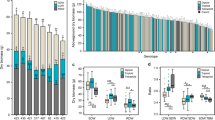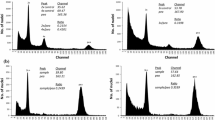Summary
Six genotypes derived from a high and low yielding selection within each of the 3 chromosome classes 27, 28 (euploid) and 29 were grown as pure stands and in all possible binary mixture combinations in a tray experiment carried out at Aberystwyth and Newcastle over a two year period. Dry matter yield, tiller number and plant height were recorded for each of several harvests each season. The results showed that:
-
1)
(i) the euploids were of high yield and average competitive ability, (ii) the hypoploids were of average yield and low competitive ability, (iii) the hyperploids were of lower than average yield and of high competitive ability;
-
2)
Insome cases significant differences were found between selections within a chromosome class;
-
3)
Mixture performance was intermediate to that of the component pure stands;
-
4)
When high yielding selections were grown in a mixture with a selection of superior competitive ability they tended to produce more tillers per unit dry weight than in pure stands. It was concluded that, until more is known of the relative performance of euploids and aneuploids, marketed seed should contain as high a proportion of euploids as possible.
Similar content being viewed by others
References
Ahloowalia, B. S., 1971. Frequency, origin and survival of aneuploids in tetraploid ryegrass. Genetica 42: 129–138.
Barclay, P. C. & J. M. Armstrong, 1966. Certain aspects of chromosome number and seed size in induced tetraploid pasture plants. Proceedings X International Grassland Congress 667–671.
Durrant, A., 1965. Analysis of reciprocal differences in diallel crosses. Heredity 20: 573–607.
Durrant, A., 1969. Phenotype analysis of diallel crosses. Heredity 24: 541–560.
Easton, H. S., 1973. Performance of aneuploids in an autotetraploid ryegrass population. New Zealand Journal of Agricultural Research 16: 35–37.
Finlay, K. W. & G. N. Wilkinson, 1963. The analysis of adaptation in a plant-breeding programme. Australian Journal of Agricultural Research 14: 742–754.
Norrington-Davies, J., 1974. Diallel analysis of competition between grass species. Journal of Agricultural Science Cambridge 71: 157–188.
Simonsen, Ø., 1973. Cytogenic investigations in diploid and autotetraploid populations of Lolium perenne L. Hereditas 75: 157–188.
Author information
Authors and Affiliations
Rights and permissions
About this article
Cite this article
Norrington-Davies, J., Moore, K. & Blijenburg, J.G. The yield and competitive ability of euploid and aneuploid genotypes of tetraploid Lolium perenne in two seasons at two locations. Euphytica 30, 675–686 (1981). https://doi.org/10.1007/BF00038796
Received:
Issue Date:
DOI: https://doi.org/10.1007/BF00038796




